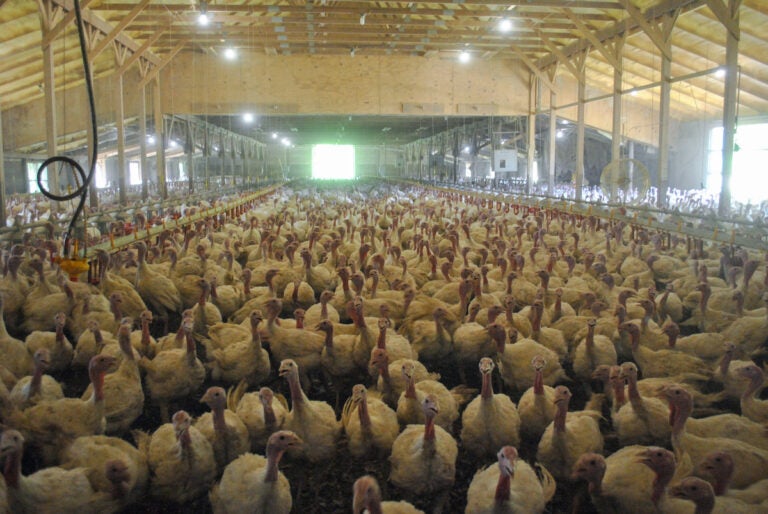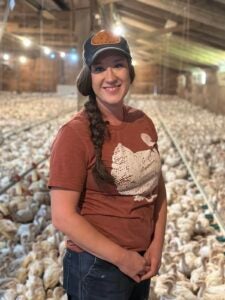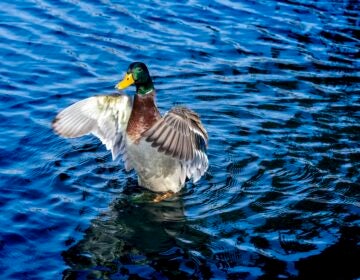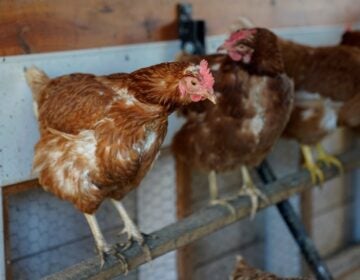How a turkey farmer dealt with an avian flu outbreak on Thanksgiving
The bird flu virus continues to spread around the world, including in mammals like cows. Scientists are worried it could become a human virus.
Listen 9:25
In 2023, the turkeys on Erica Sawatzke’s farm contracted highly pathogenic avian influenza, a deadly bird flu virus that has been spreading across the U.S. in recent years. (Courtesy of Erica Sawatzke)
This story is from The Pulse, a weekly health and science podcast.
Find it on Apple Podcasts, Spotify, or wherever you get your podcasts.
The first thing farmer Erica Sawatzke does every morning is check on her turkeys. For generations, Sawatzke and her family have run Oakdale Farm in Minnesota. They usually have tens of thousands of turkeys on their farm at a time.
But last year, the day before Thanksgiving, when Sawatzke checked on the turkeys, about 40 had died. She walked around the barn, and noticed telltale signs of illness in other turkeys. They were not eating or drinking.
“They lay down and huddle together,” she said. “They’re not active … They’re pretty quiet.”
Then on Thanksgiving, more than a hundred turkeys died.
She knew she had to test the turkeys for highly pathogenic avian influenza, a deadly bird flu virus that has been spreading across the U.S. in recent years.
“You’re wishing that it’s not that,” she said. “It’s devastating, and it’s stressful.”
Sawatzke did not get to spend the holiday with her family.
On the third day, more than 500 turkeys died, and the samples came back positive for the deadly H5N1 bird flu virus. The standard procedure for handling an outbreak is to kill the entire flock of more than 10,000 turkeys. Sawatzke had to explain to her four-year-old daughter, who normally helps her with farm work, why there were no turkeys in the barn.
“That was the first time that I’ve really ever had to explain anything, like, difficult to my child,” she said. “It was a strange, strange feeling, being in barns that are empty. It’s almost eerie.”

She and her crew cleaned and disinfected every corner of the barn, and went through inspections from local and federal health officials. She had trouble sleeping.
“My mind just never really shut off, because there’s so many things in front of you that you have to take care of.”
It was weeks before they could raise turkeys again.
Sawatzke’s farm did recover, but they’ve taken extra precautions to avoid another outbreak. They now limit the amount of people who visit; they upgraded the ventilation system; and they installed meters to track how much water the turkeys are drinking, because not drinking is a sign of illness.
Subscribe to The Pulse
Since 2022, millions of birds across almost every state in the U.S. have died or been euthanized because of highly pathogenic avian influenza. And this year, for what could be the first time, it has spread from mammal to mammal, including among dairy cows and pigs. There have been more than 40 human cases so far, and scientists are worried that if the virus continues to spread, it could become a human virus.
Turkeys are especially susceptible to the virus, said Michelle Kromm, a veterinarian in Minnesota who specializes in poultry medicine and managing outbreaks. However, she added that there are “night and day differences” between how U.S. farms are responding now, compared to the last major outbreak of avian flu, which was 10 years ago.
For instance, Jarra Jagne, a poultry specialist at the Cornell University College of Veterinary Medicine, said poultry farms are now so thorough with screening visitors, it’s hard for her to bring her classes for visits.
“Many of them make you sign … a mini contract where you tell them that you’ve not been on a farm for the past 72 hours,” she said. “Many farms also require you to shower in, or maybe even shower out.”
But what makes this time different is that the virus has made the jump to mammals like cows. Farmers and scientists know how to stop the virus from spreading among birds, but it’s as not clear what to do about cows, said Carol Cardona, an avian disease specialist at the University of Minnesota.
“If we knew that truck A was moving between a dairy farm and a poultry farm and could carry the virus, we could perhaps either stop that transportation, or that movement of the truck, or we could wash and disinfect the truck between those two premises. The problem is that we don’t really know what those pathways are.”
Virologist Richard Webby said the problem is that nobody was prepared for an outbreak in cows.
Webby has been watching this class of flu viruses since 1997, when 18 people in Hong Kong died from what was back then a new flu virus. He studies flu viruses at St. Jude’s Children’s Research Hospital in Tennessee, and also works with the World Health Organization.
He said while there have been other avian flu outbreaks in the years since 1997, it has never spread quite as far as it has this time. It’s now in most regions of the world, including in penguins in Antarctica.
He said that now it is an animal virus that could infect humans; the worry is that it could mutate into a human virus that goes from human to human.
“Flu viruses make a lot of mutations when they replicate,” he said. “Every time there’s an infected host, there’s a chance that key mutations will emerge. And … if that happens in the right place where an infected animal was in contact with humans, a human gets infected … that potentially could be the start of something like a pandemic.”
Right now, it’s flu season in the northern hemisphere, which means people are already walking around with human flu viruses, said Angela Rasmussen, a virologist at the University of Saskatchewan in Canada who studies emerging viruses, including avian flu.
She explained that the flu virus genome is in eight pieces, and if someone gets infected with two viruses at once, those pieces can shuffle like a deck of cards, in a process called reassortment.
“That can lead to new, unpredictable flu viruses with properties that we really can’t say what they are until they start spreading,” Rasmussen said. “That could happen tomorrow. It could happen years from now. It might never happen. Nobody really has an answer for this and I certainly don’t. But that’s why we kind of want to stop it before we have an opportunity to get that answer.”
She said the U.S. has not responded well so far. For instance, dairy cows do not need to be tested unless they move across states, so it’s not clear how many infected cows are out there. Colorado and Pennsylvania now require testing for the virus in milk. More recently, the U.S. Department of Agriculture announced it will start testing milk for the virus across the country.
Rasmussen added that health officials should be more proactive in vaccinating farm workers against human flu viruses, which would reduce the chances of human and bird flu viruses mixing.
“To stop a virus and outbreak from becoming a pandemic, you need to contain it at the source. We are not doing that,” she said. “We are sitting around … wishful thinking our way into potentially an influenza pandemic. And it’s extremely reckless.”
The USDA has acknowledged a request to comment on this story on October 24 and as of publication we have not heard back.
Richard Webby said a potential silver lining is that because the virus has been around for so long, there has already been years of research on vaccines. However, the problem is that the flu virus changes all the time, so a vaccine that works now may not work in the future.
He added the other problem is that while there is a lot of attention on the H5N1 bird flu virus that is circulating, there are also other viruses going around in chickens and other animals.
“it’s absolutely important to be focused on the cattle outbreak and the H5 outbreak at the moment, but we can’t forget that there are these other threats that … are also causing human infections … and also pose probably just as much, if not more of a pandemic risk, than the H5 does.”
WHYY is your source for fact-based, in-depth journalism and information. As a nonprofit organization, we rely on financial support from readers like you. Please give today.






